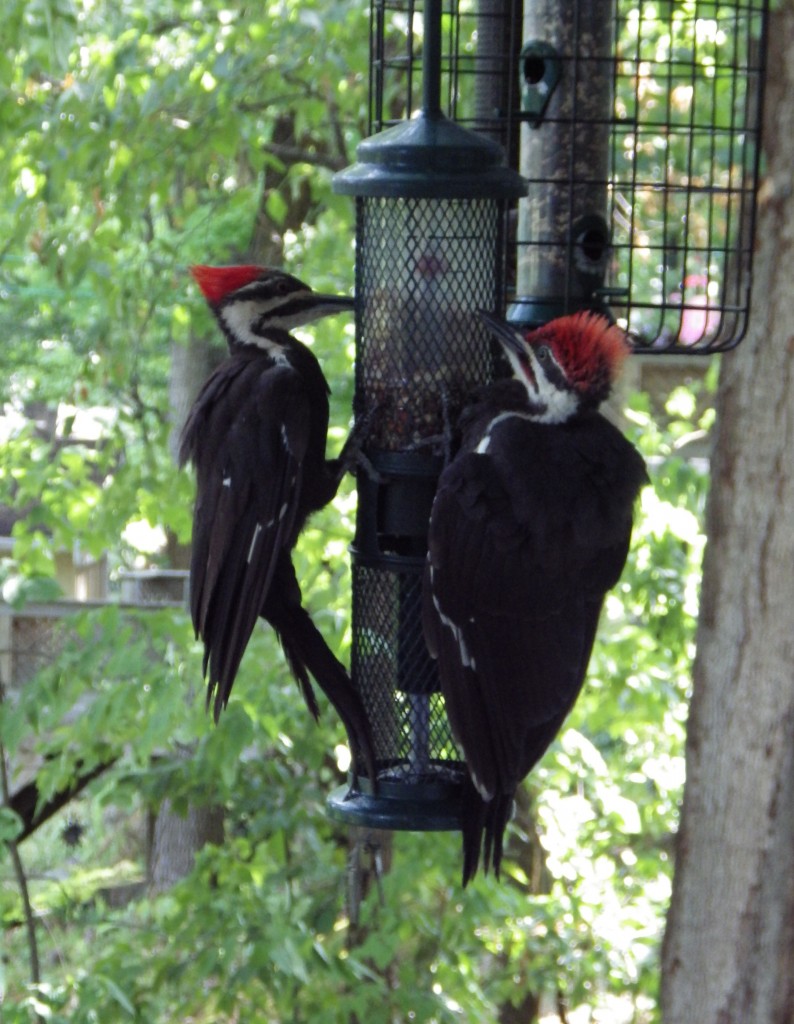Feeding birds in the summer features a different cast of characters from the usual winter crew. Nuthatches, chickadees and blue jays disappear, distracted by the duties of nest-building and egg-sitting. In their place, local woodpeckers have become regular visitors to the peanut feeder just outside our window.
Early in the season, their visits were sporadic, as adult birds dropped in for a snack. But by mid-July, families of newly-fledged young woodpeckers began to join their parents, and the visits became much more frequent. Young birds are easy to spot, since their colour patterns are less crisp than adults, and they often still have a few downy feathers showing.
First to arrive was a family of Downy Woodpeckers, the smallest of the woodpecker clan, soon to be joined by a second family of Downies. Mom and Dad came straight to the feeder, but the youngsters preferred to hang out nearby, letting it be known by their chorus of cries that they were hungry. Back and forth shuttled the adults, downloading mouthfuls of smashed peanuts into waiting bills.
A few days later, a family of Hairy Woodpeckers joined in. Hairies have the same black-and-white patterning as their Downy cousins, but they are larger and have a longer bill. For both species, only the males have a bright red patch on the back of the head.
The feeding patterns of young Hairies was all too familiar. Young birds, no doubt accustomed to being fed while in the nest, begged constantly with loud piping calls, and the adults responded with a constant shuttle of food. We wondered how long this noisy circus would continue. As it turned out, nearly a week, until the young began to land on the feeder and help themselves.
But the summer show was not over. The latest to arrive have been a mother and son duo of crow-sized Pileated Woodpeckers, giving us close-up views of one of the most spectacular of local birds. This species has a prominent red crest, slicked into a point on the adults, but spiky and frayed like a Howdy Doody crew-cut on the young bird. Despite its size and impressive beak, the young Pileated also engages in endless pleading to be fed for many days before deciding to find food on his own.
As a bonus, in the past few days a young Red-bellied Woodpecker has also appeared, likely from a nest somewhere nearby. The final members of the woodpecker clan, Yellow-bellied Sapsucker and Northern Flicker, don’t normally come to feeders but have occasionally visited nearby trees.
So are we upsetting the balance of nature by providing summer food for woodpeckers? Perhaps a little, by concentrating their numbers into a small area for a few weeks. But woodpeckers are by nature opportunists, happy to join in to take advantage of an insect outbreak or other easy food. I doubt that our peanuts will have any long-term effects.
On the other hand, watching the family life of all these woodpeckers has given us much joy and a greater understanding of the extraordinary task of raising these youngsters.
Ron Reid is the Carden Coordinator for The Couchiching Conservancy.

